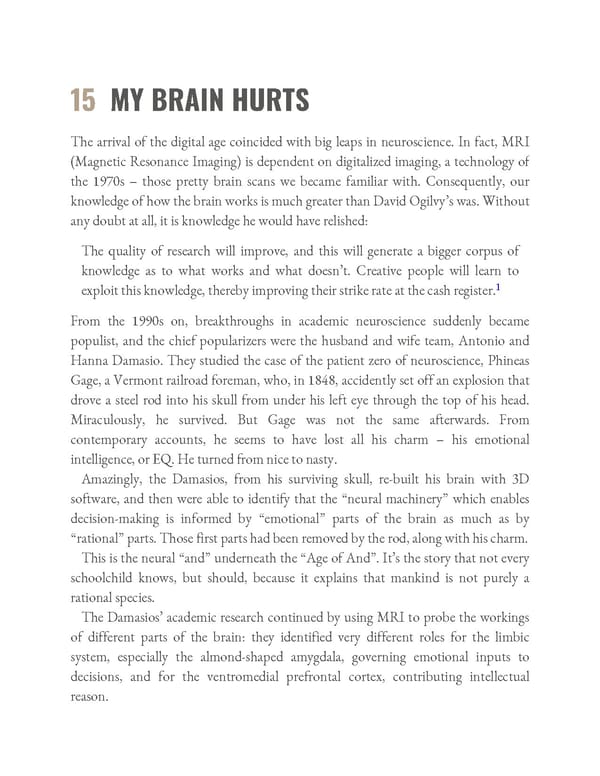15 MY BRAIN HURTS The arrival of the digital age coincided with big leaps in neuroscience. In fact, MRI (Magnetic Resonance Imaging) is dependent on digitalized imaging, a technology of the 1970s – those pretty brain scans we became familiar with. Consequently, our knowledge of how the brain works is much greater than David Ogilvy’s was. Without any doubt at all, it is knowledge he would have relished: The quality of research will improve, and this will generate a bigger corpus of knowledge as to what works and what doesn’t. Creative people will learn to 1 exploit this knowledge, thereby improving their strike rate at the cash register. From the 1990s on, breakthroughs in academic neuroscience suddenly became populist, and the chief popularizers were the husband and wife team, Antonio and Hanna Damasio. They studied the case of the patient zero of neuroscience, Phineas Gage, a Vermont railroad foreman, who, in 1848, accidently set off an explosion that drove a steel rod into his skull from under his left eye through the top of his head. Miraculously, he survived. But Gage was not the same afterwards. From contemporary accounts, he seems to have lost all his charm – his emotional intelligence, or EQ. He turned from nice to nasty. Amazingly, the Damasios, from his surviving skull, re-built his brain with 3D software, and then were able to identify that the “neural machinery” which enables decision-making is informed by “emotional” parts of the brain as much as by “rational” parts. Those first parts had been removed by the rod, along with his charm. This is the neural “and” underneath the “Age of And”. It’s the story that not every schoolchild knows, but should, because it explains that mankind is not purely a rational species. The Damasios’ academic research continued by using MRI to probe the workings of different parts of the brain: they identified very different roles for the limbic system, especially the almond-shaped amygdala, governing emotional inputs to decisions, and for the ventromedial prefrontal cortex, contributing intellectual reason.
 Ogilvy on Advertising in the Digital Age Page 397 Page 399
Ogilvy on Advertising in the Digital Age Page 397 Page 399